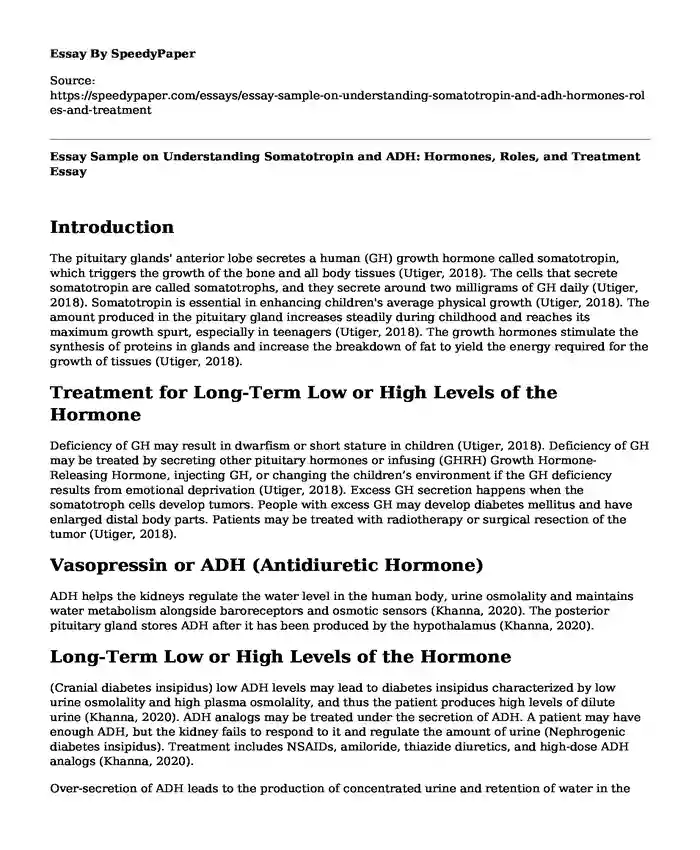Introduction
The pituitary glands' anterior lobe secretes a human (GH) growth hormone called somatotropin, which triggers the growth of the bone and all body tissues (Utiger, 2018). The cells that secrete somatotropin are called somatotrophs, and they secrete around two milligrams of GH daily (Utiger, 2018). Somatotropin is essential in enhancing children's average physical growth (Utiger, 2018). The amount produced in the pituitary gland increases steadily during childhood and reaches its maximum growth spurt, especially in teenagers (Utiger, 2018). The growth hormones stimulate the synthesis of proteins in glands and increase the breakdown of fat to yield the energy required for the growth of tissues (Utiger, 2018).
Treatment for Long-Term Low or High Levels of the Hormone
Deficiency of GH may result in dwarfism or short stature in children (Utiger, 2018). Deficiency of GH may be treated by secreting other pituitary hormones or infusing (GHRH) Growth Hormone-Releasing Hormone, injecting GH, or changing the children’s environment if the GH deficiency results from emotional deprivation (Utiger, 2018). Excess GH secretion happens when the somatotroph cells develop tumors. People with excess GH may develop diabetes mellitus and have enlarged distal body parts. Patients may be treated with radiotherapy or surgical resection of the tumor (Utiger, 2018).
Vasopressin or ADH (Antidiuretic Hormone)
ADH helps the kidneys regulate the water level in the human body, urine osmolality and maintains water metabolism alongside baroreceptors and osmotic sensors (Khanna, 2020). The posterior pituitary gland stores ADH after it has been produced by the hypothalamus (Khanna, 2020).
Long-Term Low or High Levels of the Hormone
(Cranial diabetes insipidus) low ADH levels may lead to diabetes insipidus characterized by low urine osmolality and high plasma osmolality, and thus the patient produces high levels of dilute urine (Khanna, 2020). ADH analogs may be treated under the secretion of ADH. A patient may have enough ADH, but the kidney fails to respond to it and regulate the amount of urine (Nephrogenic diabetes insipidus). Treatment includes NSAIDs, amiloride, thiazide diuretics, and high-dose ADH analogs (Khanna, 2020).
Over-secretion of ADH leads to the production of concentrated urine and retention of water in the body (edema), thus diluting blood components such as sodium (MedlinePlus, 2020). Symptoms include seizures, mental changes like strange behavior, memory problems, confusion, lack of balance, headache, vomiting, and nausea (MedlinePlus, 2020). Treatment includes limiting water intake, changing medication if the medicine is the causative agent, and removal of tumor-producing ADH through surgery (MedlinePlus, 2020).
Creative illustration (poem)
References
Khanna, A. (2020). Antidiuretic Hormone. TeachMe Physiology. https://teachmephysiology.com/urinary-system/regulation/antidiuretic-hormone/
MedlinePlus (2020). Syndrome of inappropriate antidiuretic hormone secretion. https://medlineplus.gov/ency/article/000314.htm
Utiger, R.D., (2018). Growth hormone. Encyclopedia Britannica. https://www.britannica.com/science/allometry
Cite this page
Essay Sample on Understanding Somatotropin and ADH: Hormones, Roles, and Treatment. (2023, Nov 07). Retrieved from https://speedypaper.com/essays/essay-sample-on-understanding-somatotropin-and-adh-hormones-roles-and-treatment
Request Removal
If you are the original author of this essay and no longer wish to have it published on the SpeedyPaper website, please click below to request its removal:
- Free Essay: Antibiotic Abuse Killing Thousands in Thailand
- Paper Example: The Impacts of Clinical System on Outcomes and Efficiencies
- Free Essay: Is Healthcare a Right or a Privilege?
- Paper Example on Impact of Standardized Nursing Terminology
- Essay Sample on Socratic Dialogue
- Essay Sample on Meniere Infection
- Paper Sample on Meaningful Use Certified EHR Technology System and Its Implication
Popular categories





